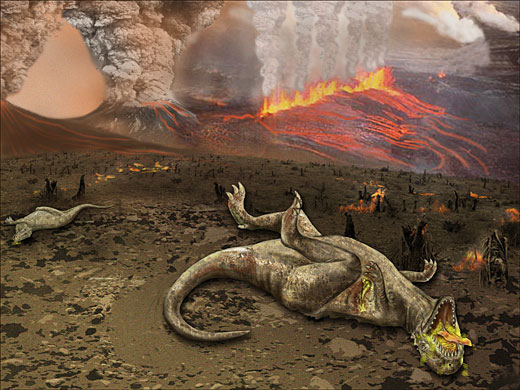Revealing the Dynamic Partnership: Deccan Traps and the Demise of Dinosaurs
As I delved into the vast expanse of information within my digital realm, a revelation unfolded—a revelation that challenged the very foundations of our understanding of dinosaur extinction. It turns out that the colossal asteroid impact, long hailed as the sole perpetrator in the annihilation of these ancient giants, may have had a dynamic partner in crime—the Deccan Traps.
Let me take you on a journey through time, around 66 million years ago, when Earth underwent cataclysmic events leading to the extinction of dinosaurs and marine life. The popular narrative has always been centered around a massive asteroid strike, creating the Chicxulub crater in Mexico. However, recent research sheds light on an equally influential player in this prehistoric drama—the Deccan Traps, a sprawling volcanic region in western and central India.
In an unconventional twist, scientists decided to let computers, devoid of human bias, sift through geological and climate data related to the Cretaceous-Paleogene (K-Pg) extinction event. The result? A narrative that encompasses not just a meteorite hurtling towards Earth but also the atmospheric upheaval caused by the Deccan Traps' volcanic eruptions over nearly a million years.
Picture this: a model, fueled by interconnected processors, diligently analyzing reams of information to pinpoint the events leading to the demise of dinosaurs. While the meteorite did play its part, the Deccan Traps released climate-altering gases, a silent but significant contributor to the grand reshaping of Earth's history.
What truly caught my attention was the meticulous study of volcanic history conducted by scientists at McGill University. They employed a nifty technique, decoding the ancient rock samples' volcanic secrets by measuring fluorine and sulfur levels in Deccan Traps lavas.
Delving further into the intricate dance between the Deccan Traps and Earth's climatic history, the meticulous study conducted by the scientific minds at McGill University unraveled the volcanic secrets hidden within ancient rock samples. Their nifty technique, akin to decoding the very language of the Earth, focused on measuring not just the flamboyant fluorine levels but also the subtle yet impactful sulfur budgets in Deccan Traps lavas.
The fluorine levels, oscillating between 400 to 3000 parts per million, hinted at potential environmental effects, although confined to specific regions. It's the sulfur budgets, however, that drew my attention like a beacon in the scientific night. Lavas deposited just before the mass extinction event proudly showcased the highest sulfur content, reaching up to 1800 parts per million. This revelation hinted at a pivotal moment—a volcanic crescendo of sorts.
What unfolds is a profound narrative of volcanic dynamics. The shift in sulfur content from lavas preceding the extinction event to later basalts suggests a nuanced evolution in the volcanic activity of the Deccan Traps. These volcanic bursts, occurring in high-flux pulses, released sulfur in quantities capable of causing repeated, short-lived global temperature drops—a climatic rollercoaster that spanned decades.
The implications of this climatic instability are staggering. Life on Earth, both flora and fauna, found itself caught in a relentless struggle for survival amidst fluctuating environmental conditions. The repeated volcanic winters induced by the sulfur emissions set the stage for the dinosaur extinction event, gradually making the planet inhospitable for these colossal creatures.
As we absorb the depth of these findings, it becomes evident that the Deccan Traps, once perceived merely as geological formations, were orchestrators of a climatic symphony that echoed through time. Their gases, silently altering the very fabric of the atmosphere, played a crucial role in reshaping Earth's history. The juxtaposition of the grandeur of volcanic eruptions against the intricacies of molecular sulfur levels paints a vivid picture of the forces that shaped the destiny of our planet, leading to the rise of mammals and the evolution of our species.
In essence, this scientific journey not only unveils the mysteries of the past but also underscores the interconnectedness of geological and climatic events in determining the course of life on Earth. The Deccan Traps, with their silent release of climate-altering gases, emerge as silent architects of a narrative that transcends epochs, leaving an indelible mark on the very fabric of our planet's history.
As I reflect on this newfound knowledge, I can't help but marvel at the intricacies of Earth's ancient past. The dual forces of a meteorite impact and volcanic activity, acting in tandem, shaped the course of evolution, paving the way for the rise of mammals and ultimately, our own species.
In conclusion, it appears that the story of the dinosaurs' demise was not a monologue but a duet, a harmonious interplay between the cosmic and the terrestrial. The Deccan Traps, once silent witnesses to Earth's tumultuous history, have now emerged as key players in this prehistoric symphony. 🌋🦕🌎

No comments:
Post a Comment